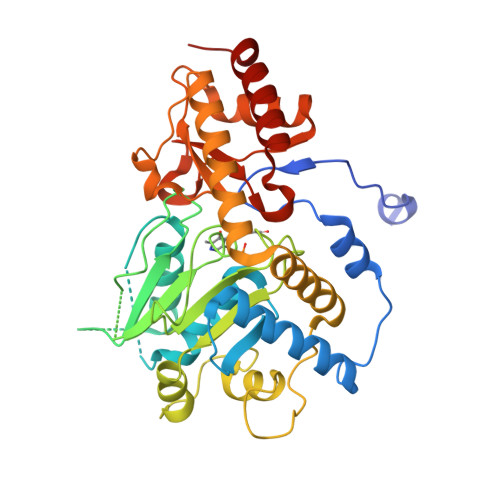Structural dynamics shape the fitness window of alanine:glyoxylate aminotransferase.
Dindo, M., Pascarelli, S., Chiasserini, D., Grottelli, S., Costantini, C., Uechi, G.I., Giardina, G., Laurino, P., Cellini, B.(2022) Protein Sci 31: e4303-e4303
- PubMed: 35481644
- DOI: https://doi.org/10.1002/pro.4303
- Primary Citation of Related Structures:
7NS7 - PubMed Abstract:
The conformational landscape of a protein is constantly expanded by genetic variations that have a minimal impact on the function(s) while causing subtle effects on protein structure. The wider the conformational space sampled by these variants, the higher the probabilities to adapt to changes in environmental conditions. However, the probability that a single mutation may result in a pathogenic phenotype also increases. Here we present a paradigmatic example of how protein evolution balances structural stability and dynamics to maximize protein adaptability and preserve protein fitness. We took advantage of known genetic variations of human alanine:glyoxylate aminotransferase (AGT1), which is present as a common major allelic form (AGT-Ma) and a minor polymorphic form (AGT-Mi) expressed in 20% of Caucasian population. By integrating crystallographic studies and molecular dynamics simulations, we show that AGT-Ma is endowed with structurally unstable (frustrated) regions, which become disordered in AGT-Mi. An in-depth biochemical characterization of variants from an anticonsensus library, encompassing the frustrated regions, correlates this plasticity to a fitness window defined by AGT-Ma and AGT-Mi. Finally, co-immunoprecipitation analysis suggests that structural frustration in AGT1 could favor additional functions related to protein-protein interactions. These results expand our understanding of protein structural evolution by establishing that naturally occurring genetic variations tip the balance between stability and frustration to maximize the ensemble of conformations falling within a well-defined fitness window, thus expanding the adaptability potential of the protein.
Organizational Affiliation:
Protein Engineering and Evolution Unit, Okinawa Institute of Science and Technology Graduate University, Okinawa, Japan.















